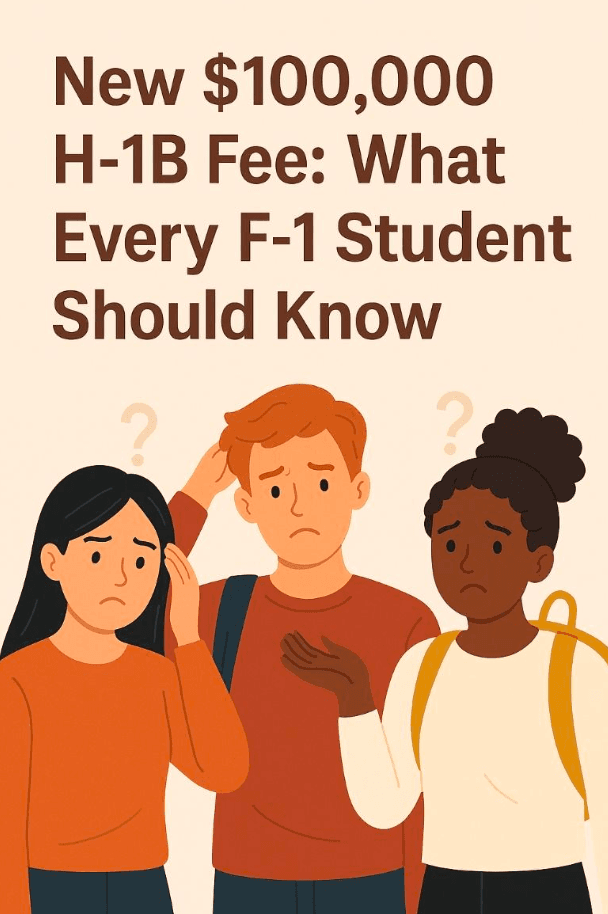The Big Shift
On Sept. 19, 2025, the White House released a proclamation titled "Restriction on Entry of Certain Non-immigrant Workers". In plain English: starting 12:01 a.m. ET, Sept. 21, 2025, if a U.S. employer files a new H-1B petition for a beneficiary who is outside the U.S. (or will require visa stamping abroad), the employer must pay a whopping US $100,000 one-time fee. Existing H-1B holders, or those changing status while staying in the U.S., are currently exempt under the wording and current guidance.
This is real. It changes the calculus for employers and job-seekers alike.
What It Means for F-1 Students
The Good News
If you're on F-1/OPT in the U.S. and your employer files a change of status (F-1 → H-1B) while you remain in the country, you're generally not subject to the $100K fee—with current guidance. That means your career pathway remains viable without being saddled by that new cost burden.
The Caution Flags
- If you travel abroad and your employer intends to file for you while you're outside, or you require consular stamping, the $100K fee may apply.
- Beyond travel, the new fee makes employers more cautious. With a higher upfront cost, they'll expect higher certainty and return on investment before sponsoring.
- Because the rule is recent and legal/regulatory interpretation is still settling, "loopholes" or fine-print may shift. Staying informed matters.
One Student's Journey: How Preparation Made the Difference
Meet Alisha, an F-1 student finishing her Master's in Biostatistics in December 2025. She knew her field was niche, but the global health analytics startup she interned at had U.S. operations and a history of H-1B filings. Here's how she prepared:
- In her final semester she treated her OPT and H-1B pathway as strategic projects, not afterthoughts. She gathered metrics: "I improved model runtime by 35%" or "I enabled reports that shaved three review days per week."
- She avoided travel abroad after filing her OPT application. Once on OPT, she remained in the U.S. and aligned her start and filing window with her employer's internal sponsorship calendar.
- She used a tool like Flashfire to track deadlines: I-20 updates, OPT application window, H-1B registration, employer sponsorship readiness.
- When her employer asked about sponsoring her after 9 months on OPT, she already had her "value narrative" ready: "Here's how I raised throughput in analytics by 28%; here's cost I saved."
Her outcome? A smooth transition to H-1B—no surprise cost, no travel-stamp panic, no scrambling.
What You Should Do This Semester
1. Flag Your Status and Travel Carefully
If you're on OPT or STEM OPT, consider limiting international travel until after your H-1B petition is filed and change of status is approved—if you want to avoid triggering potential fee consequence.
2. Align Early with Employer Strategy
Start conversations around H-1B sponsorship well before your OPT year ends. Ask:
- "Will the petition be a change of status?"
- "Will I need to travel for stamping?"
- "Does the company have a budget for the $100K cost (if required)?"
3. Build Your Story Now
Since employers face higher cost, you'll benefit from making yourself exceptional early. Keep a running log of impact: projects you led, quantifiable outcomes (e.g., reduced processing time, improved model accuracy, decreased cost).
4. Stay in the U.S. During Key Filing Window
If you stay on U.S. soil when your employer files the petition for change of status, you're in a stronger position to avoid consular processing and potentially the fee.
5. Use a Tracker
Keep key dates in one place: I-20 expiry, OPT start/end, STEM extension window, H-1B registration window, employer decision deadlines. Flashfire offers automated reminders and flagged alerts—so you're not hanging on calendar-blind.
Final Word
The US$100,000 fee marked a meaningful change in the H-1B landscape, but for you as an F-1 student it's not a barrier if you plan smart and act early. Staying in the U.S., lining up a thoughtful employer, building real-world impact, and tracking your timeline—all of this gives you control in a changing environment.
You don't just want to "stay legal." You want to thrive. Treat this as a milestone—not a risk. Use your university years to build a case, align with sponsors, and leverage every advantage you have.
If you set yourself up right, the phrasing changes from "Can I file?" to "When will I start?". And that shift makes all the difference.
